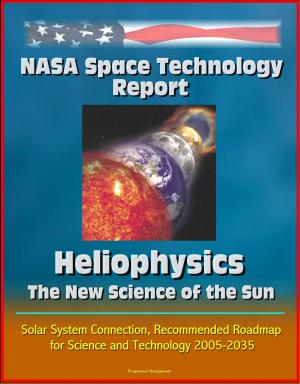Complete Guide to Weather Satellites: NOAA Polar and Geostationary Satellites, GOES, POES, JPSS, DMSP, Potential Critical Gaps in Data, Program History, Military and Earth Observation, Forecasting
Nonfiction, Science & Nature, Science, Other Sciences, Meteorology, Technology, Aeronautics & Astronautics| Author: | Progressive Management | ISBN: | 9781310389382 |
| Publisher: | Progressive Management | Publication: | January 16, 2016 |
| Imprint: | Smashwords Edition | Language: | English |
| Author: | Progressive Management |
| ISBN: | 9781310389382 |
| Publisher: | Progressive Management |
| Publication: | January 16, 2016 |
| Imprint: | Smashwords Edition |
| Language: | English |
Professionally converted for accurate flowing-text e-book format reproduction, this unique collection of government documents provides comprehensive coverage of all aspects of current and planned American weather satellites, with material from NOAA, NASA, and independent reviews of the troubled replacement program.
Contents: Launch Delayed - NOAA Faces Key Decisions on Timing of Future Satellites * Improvements Needed in NOAA's Mitigation Strategies as It Prepares for Potential Satellite Coverage Gaps * Polar Weather Satellites - NOAA Needs To Prepare for Near-term Data Gaps * Geostationary Weather Satellites - Launch Date Nears, but Remaining Schedule Risks Need to be Addressed * History of the NOAA Satellite Program * NOAA Satellite Conference 2015 Summary Report * NOAA-N Satellite, POES Program * NOAA Response - A Review of NOAA's Satellite Program: A Way Forward * NOAA's GOES R - Next Generation Satellite * NOAA Knows...Earth-Observing Satellites * Options for Modernizing Military Weather Satellites * Bridging the Gap: America's Weather Satellites and Weather Forecasting
The National Oceanic and Atmospheric Administration's (NOAA) $10.9 billion Geostationary Operational Environmental Satellite-R (GOES-R) program recently delayed the planned launch of the first satellite in the new series from March 2016 to October 2016. Based on its ongoing work, GAO found that the decision to delay the launch was due to poor schedule performance over the last few years (losing more than 10 days a month on average), recent technical issues with key components, and little schedule margin as the program entered integration testing. The October 2016 launch date may also be delayed if additional technical challenges arise or if schedule performance remains poor.
NOAA recently changed assumptions about the expected lifespan of existing GOES satellites from 7 to 10 years based on the longevity of prior satellites. However, the analysis supporting this change is over 10 years old. Even with this extension, NOAA may fall short of its policy of having 2 operational satellites and 1 backup satellite in orbit. The agency faces an 11 month gap in backup coverage until GOES-R is operational, during which time there would be only 2 operational satellites. Any further delays in the GOES-R launch date could exacerbate that gap. NOAA is now facing important decisions on when to launch the remaining satellites in the GOES-R series to maximize satellite coverage while minimizing development and storage costs.
Based on its ongoing work, GAO found that NOAA's $11.3 billion Joint Polar Satellite System (JPSS) program is making progress toward the planned launch of the JPSS-1 satellite in March 2017. However, the program has experienced technical issues that have affected internal schedule deadlines, such as an issue with debris in an instrument's subsystem that delayed its delivery by approximately 8 months, and faces key risks in the remainder of development. NOAA is also facing the risk of a potential near-term gap in polar data prior to the launch of the JPSS-1 satellite. Similar to the decision on the GOES satellites, in April 2015, NOAA revised its assumptions about the expected life of the satellite that is currently in-orbit by adding up to 4 years, which would reduce the chance of a near-term gap. However, risks to the performance and health of the on-orbit satellite, and to development of the JPSS-2 satellite could increase the risk of a gap. Also, NOAA faces key decisions on timing the development and launch of the remaining JPSS satellites to ensure satellite continuity while balancing the possibility that satellites could last much longer than anticipated.
Professionally converted for accurate flowing-text e-book format reproduction, this unique collection of government documents provides comprehensive coverage of all aspects of current and planned American weather satellites, with material from NOAA, NASA, and independent reviews of the troubled replacement program.
Contents: Launch Delayed - NOAA Faces Key Decisions on Timing of Future Satellites * Improvements Needed in NOAA's Mitigation Strategies as It Prepares for Potential Satellite Coverage Gaps * Polar Weather Satellites - NOAA Needs To Prepare for Near-term Data Gaps * Geostationary Weather Satellites - Launch Date Nears, but Remaining Schedule Risks Need to be Addressed * History of the NOAA Satellite Program * NOAA Satellite Conference 2015 Summary Report * NOAA-N Satellite, POES Program * NOAA Response - A Review of NOAA's Satellite Program: A Way Forward * NOAA's GOES R - Next Generation Satellite * NOAA Knows...Earth-Observing Satellites * Options for Modernizing Military Weather Satellites * Bridging the Gap: America's Weather Satellites and Weather Forecasting
The National Oceanic and Atmospheric Administration's (NOAA) $10.9 billion Geostationary Operational Environmental Satellite-R (GOES-R) program recently delayed the planned launch of the first satellite in the new series from March 2016 to October 2016. Based on its ongoing work, GAO found that the decision to delay the launch was due to poor schedule performance over the last few years (losing more than 10 days a month on average), recent technical issues with key components, and little schedule margin as the program entered integration testing. The October 2016 launch date may also be delayed if additional technical challenges arise or if schedule performance remains poor.
NOAA recently changed assumptions about the expected lifespan of existing GOES satellites from 7 to 10 years based on the longevity of prior satellites. However, the analysis supporting this change is over 10 years old. Even with this extension, NOAA may fall short of its policy of having 2 operational satellites and 1 backup satellite in orbit. The agency faces an 11 month gap in backup coverage until GOES-R is operational, during which time there would be only 2 operational satellites. Any further delays in the GOES-R launch date could exacerbate that gap. NOAA is now facing important decisions on when to launch the remaining satellites in the GOES-R series to maximize satellite coverage while minimizing development and storage costs.
Based on its ongoing work, GAO found that NOAA's $11.3 billion Joint Polar Satellite System (JPSS) program is making progress toward the planned launch of the JPSS-1 satellite in March 2017. However, the program has experienced technical issues that have affected internal schedule deadlines, such as an issue with debris in an instrument's subsystem that delayed its delivery by approximately 8 months, and faces key risks in the remainder of development. NOAA is also facing the risk of a potential near-term gap in polar data prior to the launch of the JPSS-1 satellite. Similar to the decision on the GOES satellites, in April 2015, NOAA revised its assumptions about the expected life of the satellite that is currently in-orbit by adding up to 4 years, which would reduce the chance of a near-term gap. However, risks to the performance and health of the on-orbit satellite, and to development of the JPSS-2 satellite could increase the risk of a gap. Also, NOAA faces key decisions on timing the development and launch of the remaining JPSS satellites to ensure satellite continuity while balancing the possibility that satellites could last much longer than anticipated.















